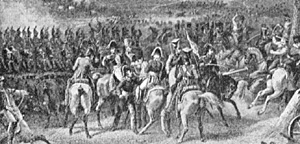
Having read Mr. Renner's review of Napoleon at Leipzig prior to publication, I find that I have some opinions to offer as counterpoints to his article.
First of all, I think the overall quality of the graphics in the game is quite low. The counters are a nightmarish mix of glaring colors. The maps are better, but they display several anomalies. The roads are printed in bright yellow; this destroys the pleasing effect of the green/gold terrain.
Furthermore, the rivers are gray, not blue. Surely pollution was not this bad in the early 19th Century! The symbols used to denote towns are rectangular blocks with an attempted three dimensional perspective. Unfortunately, they are clearly hand- drawn and give the map a sloppy look. Finally, a glance at the terrain effects chart reveals that there is no clear terrain at all! Instead, the dark green hexes are called slopes and the light green hexes are called gullies. Whatever the name, they have identical effects upon movement and combat.
Most of the graphics problems with the counters and maps probably could have been solved through use of less intense shades of colors. The marking of the units with their corps designations in a different color is a very good idea, spoiled only by the neon-sign effect of the counters. Likewise, the yellow roads would have enhanced rather than detracted from the map if they were not so intense.
All-in-all, I think these problems can be attributed to the comparative youth of OSG as an organization. That is to say, they do not have the accumulated experience to transfer all of their graphic ideas successfully into print. Hopefully, they will learn through experience.
An area related to graphics is type- setting. Here, as before, NAL reveals some uneven edges. The purpose of typesetting is to give the printed product an attractive appearance. This does mean more than merely insuring that the lines are the same length in each column of print. In NAL, the spacing between the major rules seems to have been randomly chosen, with some of the rules titles drowning in space between the sections while others are crammed in with absolutely no room to spare. What with the three blank lines in the middle of a rule on page 4, the effect is a very uneven appearance. Another area, not strictly typesetting per se, is their use of capitalization. It seems that almost every noun and every other adjective is capitalized. This is excessive overkill; a less heavy hand on the upper case would result in a smoother appearing text. Perhaps many will feel these points inconsequential, but I feel that anything offered as a professional product should have a professional appearance.
Turning to the rules themselves, I must disagree with Mr. Renner's assessment that NAL resembles SPI's Borodino. While Borodino may be the grandfather of NAL, a better resemblance can be found in SPI's Napoleon's Last Battles, as claimed on the NAL box. With the exception of the Grand Tactical Game, I could find only one major innovation over NLB. In NLB, units out of command had to automatically retreat out of enemy ZOCs; rather than a detriment, this allowed the weaker side to maintain an intact line by deliberately placing their units out of command and thus retreating into a pre-planned line. NAL solves this by removing this case entirely; units out of command may not disengage but must adhere to the normal ZOC and combat rules.
As an aside, the resemblence to NLB may be closer than you think. I was quite surprised to discover in the victory conditions (on page 7) a reference to the Anglo-Allied Army. This is a curious occurrence, for the Anglo-Allied Army is in NLB, not NAL! Was something copied a little too accurately and not caught in the editing? In any event, it gave me a hint why there are things called "chateaux" in Germany.
The game seems to play fairly well, although I must caution you I have not given this aspect a detailed examination. One thing that did annoy me was the difficulty in trying to set up any of the scenarios or the campaign game. While the campaign game has the start positions printed on the map, the overall size of the maps coupled with the dark green terrain insures that several units will be overlooked in deployment.
The start locations are specified for all scenarios in the study booklet, but even the smallest scenario, involving only a fraction of all the units, requires you to wade through ten pages of text. On top of that, the strengths of the units are not given; the set up mentions only if the unit starts at full or reduced strength. For example, "Corps Artillery. 56 guns. 7 Foot batteries." starts the campaign in "16:F.5213S".
In conclusion, I find it difficult to recommend this game. Once in play, it has all the enjoyment of an actionpacked battle along the lines of NLB, which is a point in its favor. However, the poor graphics, confusing deployment information, and high price ($18) leave me wondering if the ticket is really worth it.
Napoleon at Leipzig (Game Review)
Back to Grenadier Number 7 Table of Contents
Back to Grenadier List of Issues
Back to MagWeb Master Magazine List
© Copyright 2001 by Pacific Rim Publishing
This article appears in MagWeb (Magazine Web) on the Internet World Wide Web. Other military history articles and gaming articles are available at http://www.magweb.com